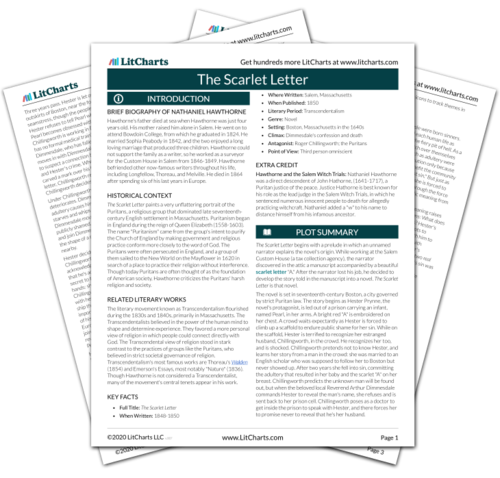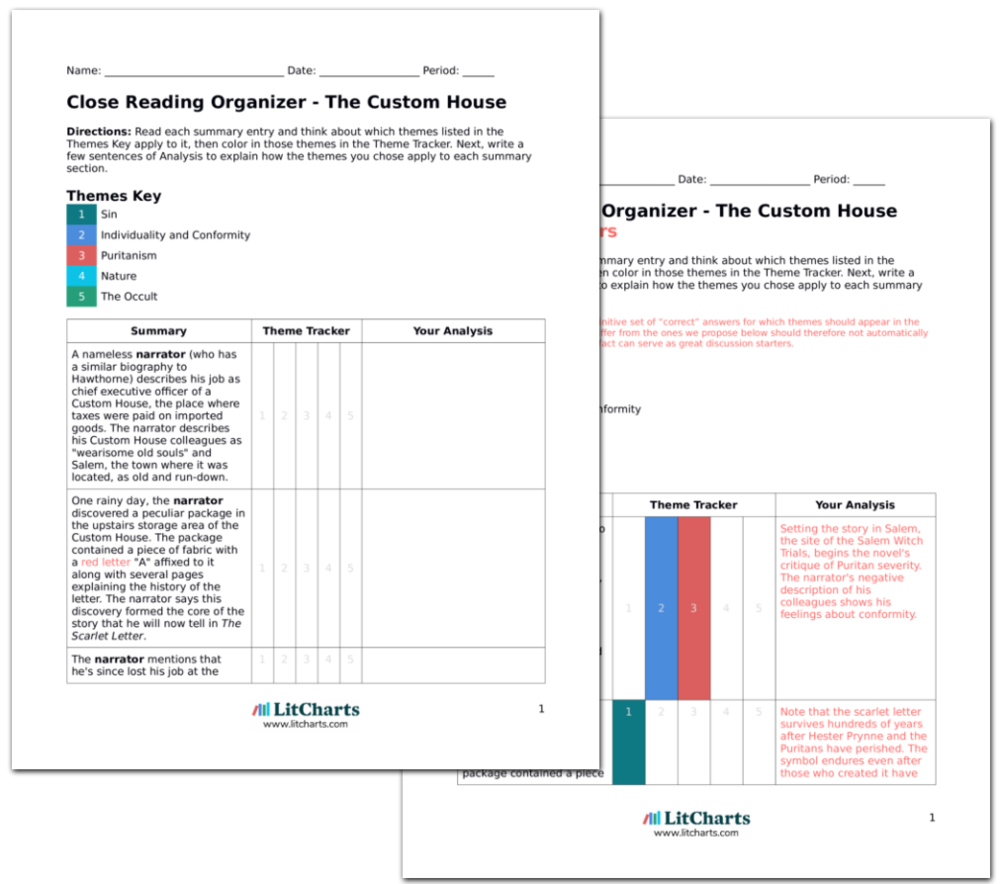
Welcome to the LitCharts study guide on Nathaniel Hawthorne's The Scarlet Letter. Created by the original team behind SparkNotes, LitCharts are the world's best literature guides.
A concise biography of Nathaniel Hawthorne plus historical and literary context for The Scarlet Letter.
Hawthorne's father died at sea when Hawthorne was just four years old. His mother raised him alone in Salem. He went on to attend Bowdoin College, from which he graduated in 1824. He married Sophia Peabody in 1842, and the two enjoyed a long loving marriage that produced three children. Hawthorne could not support the family as a writer, so he worked as a surveyor for the Custom House in Salem from 1846-1849. Hawthorne befriended other now-famous writers throughout his life, including Longfellow, Thoreau, and Melville. He died in 1864 after spending six of his last years in Europe.
Get the entire The Scarlet Letter LitChart as a printable PDF."My students can't get enough of your charts and their results have gone through the roof." -Graham S.

The Scarlet Letter paints a very unflattering portrait of the Puritans, a religious group that dominated late seventeenth-century English settlement in Massachusetts. Puritanism began in England during the reign of Queen Elizabeth (1558-1603). The name "Puritanism" came from the group's intent to purify the Church of England by making government and religious practice conform more closely to the word of God. The Puritans were often persecuted in England, and a group of them sailed to the New World on the Mayflower in 1620 in search of a place to practice their religion without interference. Though today Puritans are often thought of as the foundation of American society, Hawthorne criticizes the Puritans' harsh religion and society.
The literary movement known as Transcendentalism flourished during the 1830s and 1840s, primarily in Massachusetts. The Transcendentalists believed in the power of the human mind to shape and determine experience. They favored a more personal view of religion in which people could connect directly with God. The Transcendental view of religion stood in stark contrast to the practices of groups like the Puritans, who believed in strict societal governance of religion. Transcendentalism's most famous works are Thoreau's Walden (1854) and Emerson's Essays, most notably "Nature" (1836). Though Hawthorne is not considered a Transcendentalist, many of the movement's central tenets appear in his work.
Key Facts about The Scarlet LetterHawthorne and the Salem Witch Trials: Nathaniel Hawthorne was a direct descendent of John Hathorne, (1641-1717), a Puritan justice of the peace. Justice Hathorne is best known for his role as the lead judge in the Salem Witch Trials, in which he sentenced numerous innocent people to death for allegedly practicing witchcraft. Nathaniel added a "w" to his name to distance himself from his infamous ancestor.
Cite This Page Download this Chart (PDF)
“Would not have made it through AP Literature without the printable PDFs. They're like having in-class notes for every discussion!”
Get the Teacher Edition
“This is absolutely THE best teacher resource I have ever purchased. My students love how organized the handouts are and enjoy tracking the themes as a class.”
Copyright © 2024 All Rights Reserved Save time. Stress less.AI Tools for on-demand study help and teaching prep.
 Quote explanations, with page numbers, for over 44,123 quotes.
Quote explanations, with page numbers, for over 44,123 quotes. PDF downloads of all 1,994 LitCharts guides.
PDF downloads of all 1,994 LitCharts guides. Expert analysis to take your reading to the next level.
Expert analysis to take your reading to the next level. Advanced search to help you find exactly what you're looking for.
Advanced search to help you find exactly what you're looking for.
 Expert analysis to take your reading to the next level.
Expert analysis to take your reading to the next level. Advanced search to help you find exactly what you're looking for.
Advanced search to help you find exactly what you're looking for.